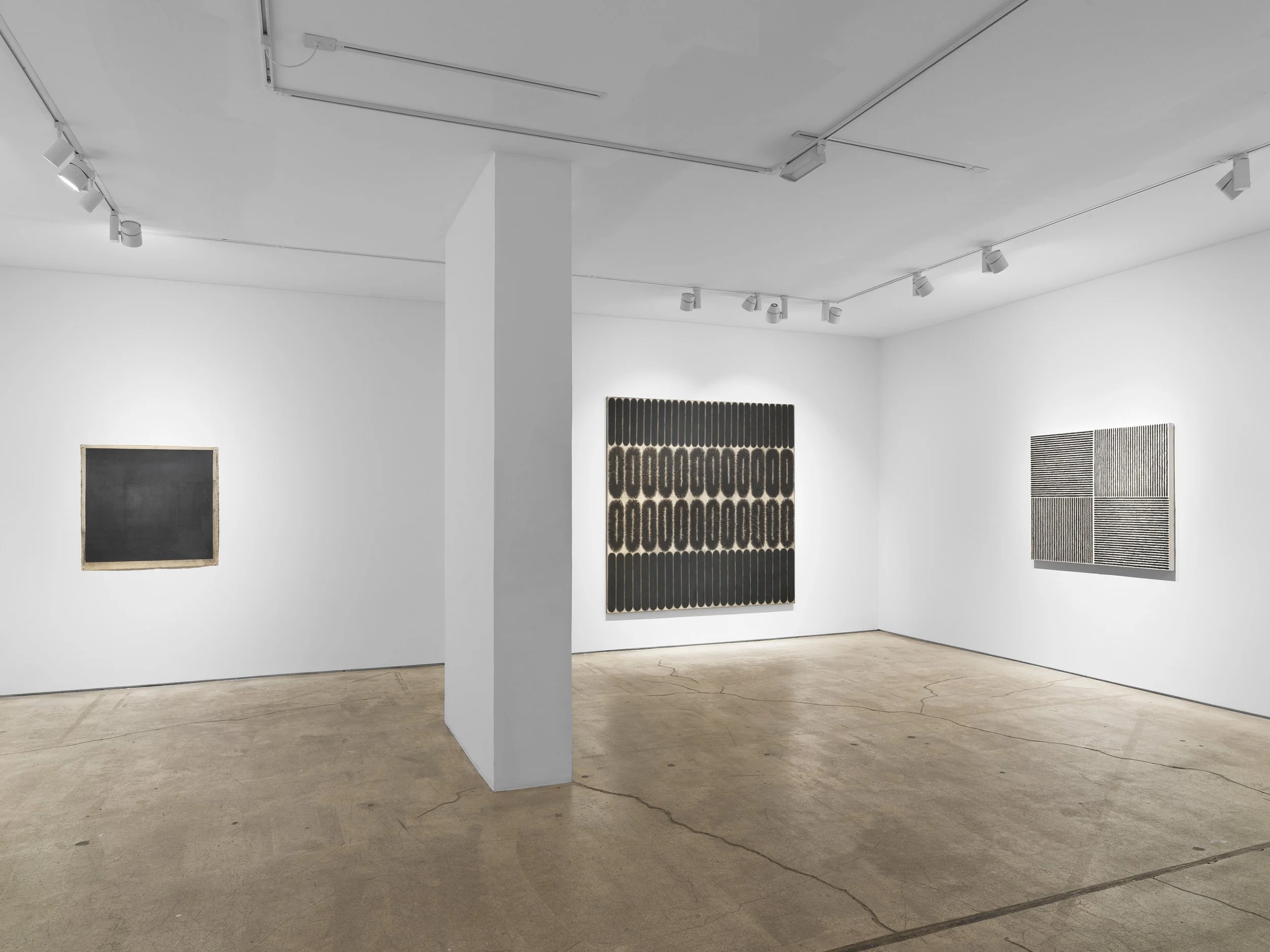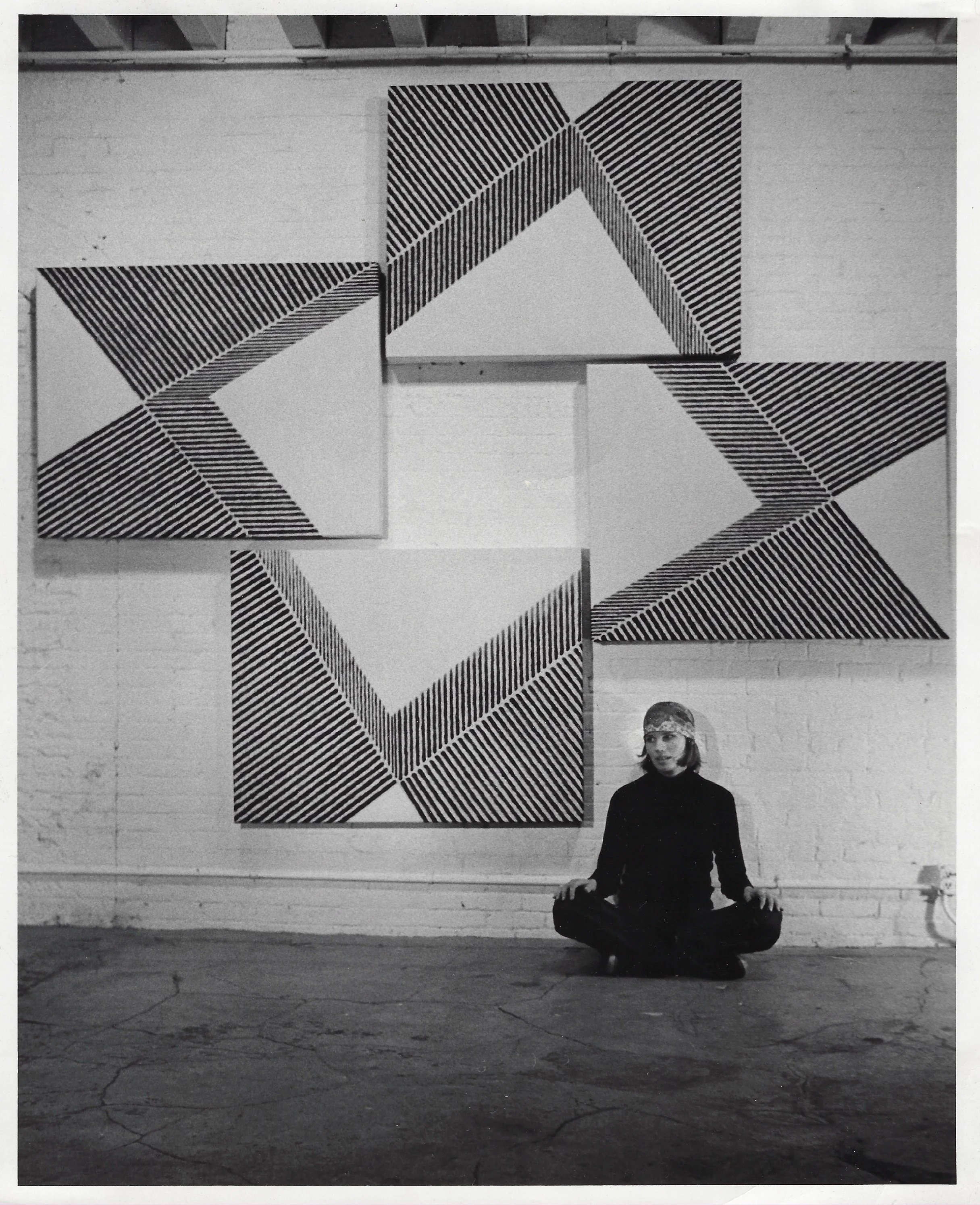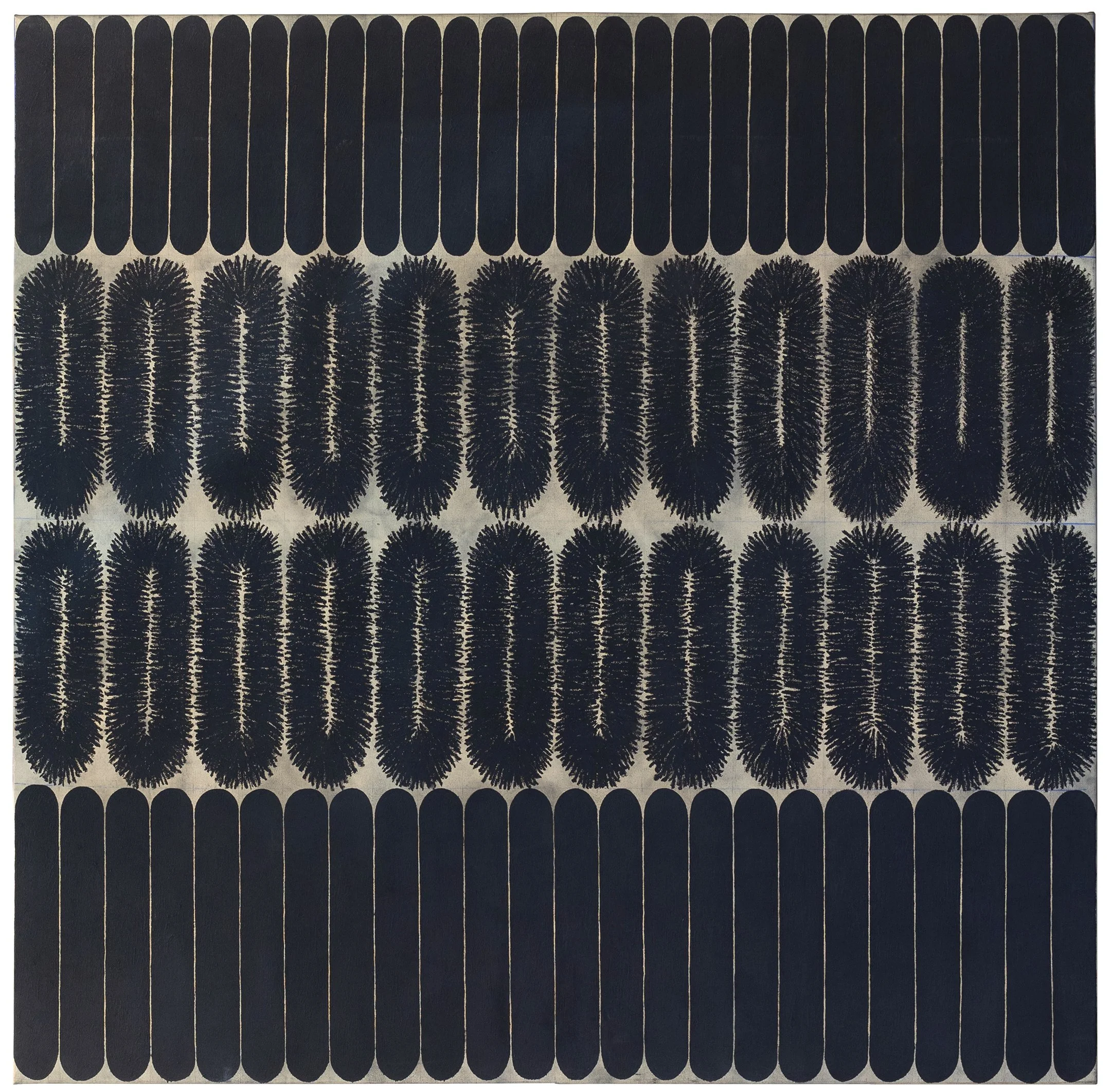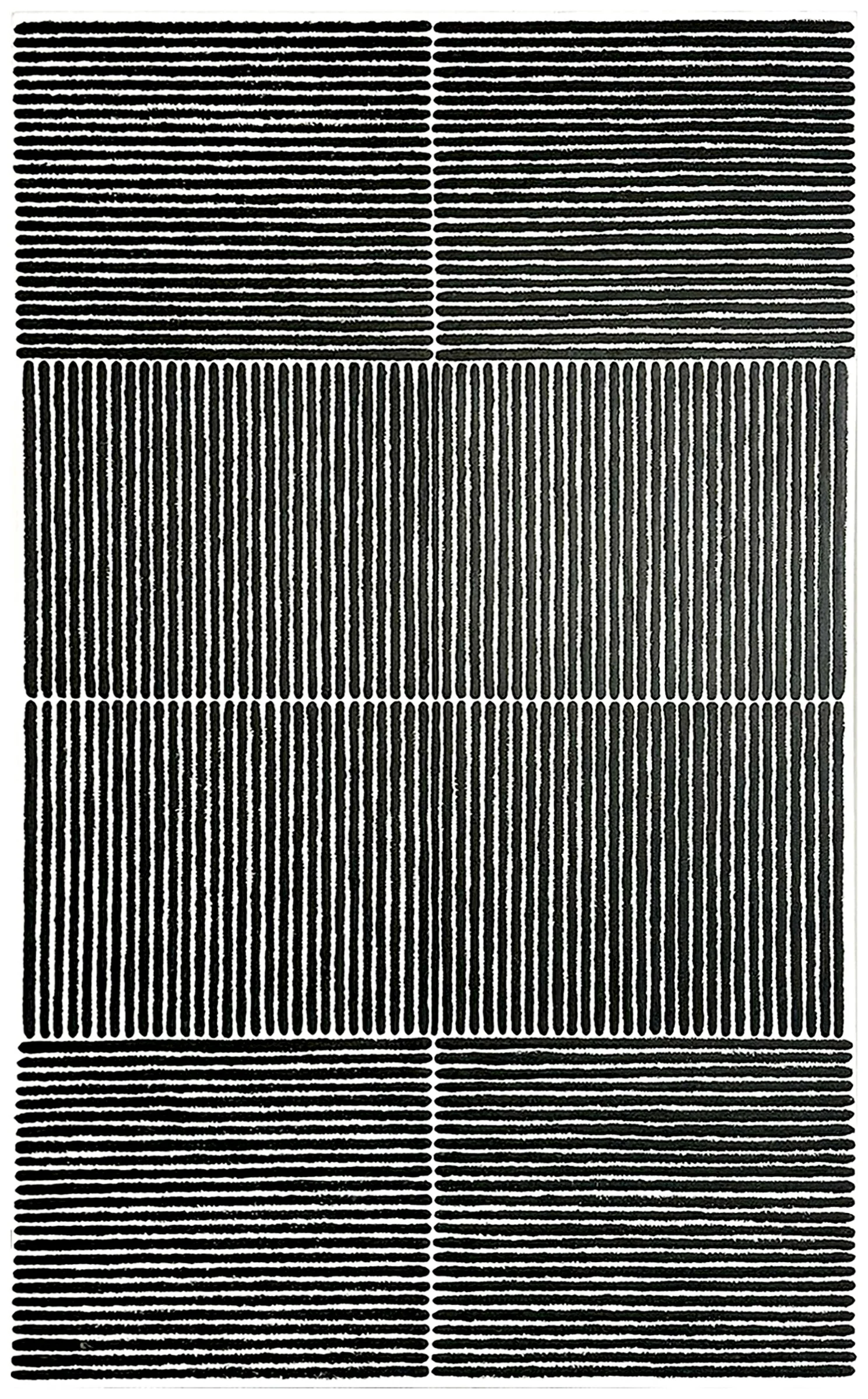Major Survey Opens at Hunter Dunbar, New York
Joan Witek in her Duane Street studio, with Untitled, 1974, Oil and pencil on canvas (four parts), 102 x 124 in. (259.1 x 315 cm) © 2025 Joan Witek / Artists Rights Society (ARS)
New York, NY – Hunter Dunbar Projects is pleased to announce a survey of works by Joan Witek (b.1943). Organized in collaboration with Artist Estate Studio, LLC, the presentation will highlight major paintings by Witek spanning over five decades—from 1969 to 2012. On view from September 4th through October 18th, 2025, the opening reception at the gallery will take place on Thursday, September 4th from 6:00pm to 8:00pm.
A prominent figure in the downtown New York art scene since the 1970s, Witek worked primarily in monochromatic painting: foregrounding gesture and surface, and emphasizing repetition, layering, and materiality. With echoes of Minimalism, Process Art, and Abstract Expressionism, Witek’s restrained work illustrates the artist’s long-time desire to reconcile geometry, abstraction, and emotion. “People have more feelings for proportion than they know,” she said in 1984.
In the mid-1970’s, Witek’s work took a turn from its gestural, abstract roots as she embraced geometric forms and started exploring the infinite nuance of a singular color—black. The monumental, four-part canvas Untitled (1974), was conceived by Witek after seeing the all-black oil stick works of her long-time Tribeca neighbor Richard Serra, as well as the experimental black canvases of Frank Stella, Ellsworth Kelly, and Ad Reinhardt. Witek found black irresistible, describing the color as “sophisticated and primitive, emotional and intellectual.”
Through the reduction of her palette, Witek allowed mark-making, space, and texture to convey diverse concepts of anthropological, literary, and experiential origin. The artist’s signature lozenge shapes – adopted from the New Guinea bark paintings she studied during her tenure as a curator at the Metropolitan Museum of Art – illustrate her deft incorporation of non-objective formality into more elaborate and subjective content. The fact that “seemingly simple forms and just one color could emote” showed the artist the potential of self-imposed limitations.
Joan Witek, "Camouflaged by Frailties [P(S)-027]," 1979, Oil stick and graphite on canvas, 685 ¼ x 85 ¼ in (216.55 × 216.55 cm)
In the 1980s and 1990s, Witek began creating ‘stroke’ paintings that marked a significant development in her practice. The works, which she refers to as “black impressionism,” balance fulsome black forms with breaks in the canvas. The 1984 painting Camouflaged by Frailties [P(S)-27], is densely filigreed, with oblong forms that cluster, reiterate, and collate. The lozenges seemingly interact with––and tremble against––each other, acting in a wider, reductive language she often referred to as “handwriting.”
In the 2000s, Witek further developed aesthetically and conceptually. The Fable of Arachne (after Velázquez) [P-125] (2005), composed of black oil stick laid over white gesso, uses areas of negative space to visually ventilate the orchestrations of its textured black sinews. The markings mimic motifs drawn from ancient texts, pictographs, and hieroglyphs. It is one of the many works on public view here for the first time.
Joan Witek, Untitled [P-159], 2012, Oil stick and graphite on canvas, 73 3/4 x 45 in (187.3 x 114.3 cm)
P-159 (2012) is a towering work made of meditative strokes which, despite their muscular application, are extraordinarily soft, expressive and poetic. The canvas is the pinnacle for an artist whose work has consistently evolved toward an identity of refinement.
A historic survey of the artist’s works on paper will be presented concurrently as a virtual exhibition.












JOAN WITEK (b. 1943) has been probing the complexities, meanings, and infinite variety of the color black for her entire artistic life. While appearing to be simple and easily grasped there is an ongoing language of proportion and meaning in this resolute abstraction. Black is usually considered the absence of color. It is severe, rigorous, associated with death, or depression or repression. But as Lilly Wei has written: “Witek plays these oppositions in her work: black being ascetic and alluring, meditative and expressive, flawless and flawed, fierce and demure, a distinct unequivocal presence, yet subtle, elusive.”
Selected Monographic Exhibitions: Hunter Dunbar Projects, New York (2025); Museum Wilhelm Morgner, Soest, Germany (2021); Minus Space, Brooklyn (2020); Jason McCoy Gallery, New York (2015); Outlet Fine Art, Brooklyn (2014); Kunstmuseum Wilhelm-Morgner-Haus, Soest, Germany (2013); Kouros Gallery, New York (2003); Gallery Niklas von Bartha, London (2019, 2003, 2000); CDS Gallery, New York (2001); Sean Scully Studio, New York (2000); Kendall Campus Art Gallery, Miami-Dade Community College, Miami (1993); John Davis Gallery, New York (1988, 1987); Wynn Kramarsky, New York (1997); Carnegie Museum of Art, Pittsburgh (1984); Rosa Esman (1985, 1984); Aames Gallery, New York (1975)
Selected Group Exhibitions: Ninth Street and Beyond: 70 Years of Women in Abstraction, Hunter Dunbar Projects, New York (2022); Crossroads, 1945 to Now, Carnegie Museum of Art, Pittsburgh (2018); Salon Zürcher, Zürcher Gallery, New York (2018); Painting Black, Raum Schroth im Museum Wilhelm Morgner, Soest (2017); Between a Place and Candy: new works in pattern, repetition and motif, UBS Art Gallery, New York (2015); Drawn / Taped / Burned: Abstraction on Paper, Katonah Museum of Art (2011); Black and White, Gallerie Weinberger, Copenhagen, Denmark (2010); Sammlung Schroth, Kloster Wedinghausen, Arnsberg, Germany (2012, 2011), Gallery Niklas von Bartha, London (2009); New York New Drawings: 1946-2007, Museu de Arte Contemporáneo Esteban Vicente, Segovia (2009); Visible Places: Works by Women on Paper, San Diego Museum of Art (2008); Fine Lines: From the Collection of Wynn Kramarsky, Santa Barbara Contemporary Arts Forum, Santa Barbara (2003); Drawing is another kind of language: Recent American Drawings from a New York Private Collection, Harvard Universtiy Art Museums, Cambridge (1997); The Whole World in a Small Painting, Trans Hudson Gallery, New York (1997); Recent Acquisitions: Milton Avery, Lois Lane, Louise Nevelson, George Rouault, Joan Witek, and Others, Kendall Campus Art Gallery, Miami-Dade Comunity College, Miami (1995); Slow Art: Painting in New York Now, MoMa PS1, Long Island City (1992); Reinstallation of the Contemporary Galleries, The Museum of Modern Art, New York (1985); Drawings and Sculpture: Alan Cote, Mark di Suvero, Brice Marden, Robert Moskowitz, Joan Witek, Manhattan Art, New York (1985); From Avery to Zurbarán: A New View of the Permanent Collection, Santa Barbara Museum of Art, Santa Barbara (1983); Selections in Contemporary Art by John Caldwell, Ben Heller, Robert Reed, Town Hall Gallery, Westport (1983); Dark Thoughts: Black Painting, Pratt Manhattan Center Art Gallery (1981); Women Artists from New York, SUNY Stony Brook University (1978); A Painting Show at PS 1, PS1, Long Island City (1977); Queens Artists ‘76, Queens Museum, Flushing Meadows, NY (1976)
Selected Public Collections: The Baltimore Museum of Art (MD), The Buffalo AKG Art Museum (NY), Arkansas Arts Center (AR), Carnegie Museum of Art (PA), Colby Museum of Art (ME), Harvard Museums (MA), Hirshhorn Museum and Sculpture Garden (DC); Kunst Museum Winterthur (Germany), Metropolitan Museum of Art (NY), Minneapolis Institute of Art (MN), The Museum of Modern Art (NY), National Gallery of Art (DC), San Francisco Museum of Modern Art (CA), and the Yale University Art Gallery (CT) among others.


